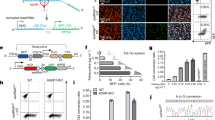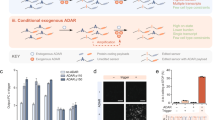Abstract
With the increasing availability of single-cell transcriptomes, RNA signatures offer a promising basis for targeting living cells. Molecular RNA sensors would enable the study of and therapeutic interventions for specific cell types/states in diverse contexts, particularly in human patients and non-model organisms. Here we describe a modular, programmable system for live RNA sensing using adenosine deaminases acting on RNA (RADAR). We validate, and then expand, our basic design, characterize its performance, and analyze its compatibility with human and mouse transcriptomes. We identify strategies to boost output levels and improve the dynamic range. Additionally, we show that RADAR enables compact AND logic. In addition to responding to transcript levels, RADAR can distinguish disease-relevant sequence alterations of transcript identities, such as point mutations and fusions. Finally, we demonstrate that RADAR is a self-contained system with the potential to function in diverse organisms.
This is a preview of subscription content, access via your institution
Access options
Access Nature and 54 other Nature Portfolio journals
Get Nature+, our best-value online-access subscription
$29.99 / 30 days
cancel any time
Subscribe to this journal
Receive 12 print issues and online access
$209.00 per year
only $17.42 per issue
Buy this article
- Purchase on Springer Link
- Instant access to full article PDF
Prices may be subject to local taxes which are calculated during checkout



Similar content being viewed by others
Data availability
Plasmids and plasmid maps have been deposited to Addgene. Next-generation sequencing data have been submitted to the Sequencing Read Archive under BioProject accession PRJNA874842. Raw flow cytometry data is available upon request from the corresponding author.
Code availability
Code for designing sensors and the bioinformatics analysis of mouse and human transcriptomes are available at https://github.com/kristjaneerik/radar-rna-sensing.
Change history
23 November 2022
A Correction to this paper has been published: https://doi.org/10.1038/s41587-022-01617-3
References
Kulkarni, A., Anderson, A. G., Merullo, D. P. & Konopka, G. Beyond bulk: a review of single cell transcriptomics methodologies and applications. Curr. Opin. Biotechnol. 58, 129–136 (2019).
Xie, Z., Wroblewska, L., Prochazka, L., Weiss, R. & Benenson, Y. Multi-input RNAi-based logic circuit for identification of specific cancer cells. Science 333, 1307–1311 (2011).
Xie, Z., Liu, S. J., Bleris, L. & Benenson, Y. Logic integration of mRNA signals by an RNAi-based molecular computer. Nucleic Acids Res. 38, 2692–2701 (2010).
Han, S.-P. et al. Programmable siRNA pro-drugs that activate RNAi activity in response to specific cellular RNA biomarkers. Mol. Ther. Nucleic Acids 27, 797–809 (2022).
Ying, Z.-M., Wang, F., Chu, X., Yu, R.-Q. & Jiang, J.-H. Activatable CRISPR transcriptional circuits generate functional RNA for mRNA sensing and silencing. Angew. Chem. Int. Ed. Engl. 59, 18599–18604 (2020).
Lin, J., Wang, W.-J., Wang, Y., Liu, Y. & Xu, L. Building endogenous gene connections through RNA self-assembly controlled CRISPR/Cas9 sunction. J. Am. Chem. Soc. 143, 19834–19843 (2021).
Hochrein, L. M., Li, H. & Pierce, N. A. High-performance allosteric conditional guide RNAs for mammalian cell-selective regulation of CRISPR/Cas. ACS Synth. Biol. 10, 964–971 (2021).
Hanewich-Hollatz, M. H., Chen, Z., Hochrein, L. M., Huang, J. & Pierce, N. A. Conditional guide rnas: programmable conditional regulation of crispr/cas function in bacterial and mammalian cells via dynamic RNA nanotechnology. ACS Cent. Sci. 5, 1241–1249 (2019).
Zhao, E. M. et al. RNA-responsive elements for eukaryotic translational control. Nat. Biotechnol. 40, 539–545 (2021).
Hur, S. Double-stranded RNA sensors and modulators in innate immunity. Annu. Rev. Immunol. 37, 349–375 (2019).
Gallo, A., Vukic, D., Michalík, D., O’Connell, M. A. & Keegan, L. P. ADAR RNA editing in human disease; more to it than meets the I. Hum. Genet. 136, 1265–1278 (2017).
Goodman, R. A., Macbeth, M. R. & Beal, P. A. ADAR proteins: structure and catalytic mechanism. Curr. Top. Microbiol. Immunol. 353, 1–33 (2012).
Gatsiou, A., Vlachogiannis, N., Lunella, F. F., Sachse, M. & Stellos, K. Adenosine-to-inosine RNA editing in health and disease. Antioxid. Redox Signal. 29, 846–863 (2018).
Katrekar, D. et al. In vivo RNA editing of point mutations via RNA-guided adenosine deaminases. Nat. Methods 16, 239–242 (2019).
Qu, L. et al. Programmable RNA editing by recruiting endogenous ADAR using engineered RNAs. Nat. Biotechnol. 37, 1059–1069 (2019).
Merkle, T. et al. Precise RNA editing by recruiting endogenous ADARs with antisense oligonucleotides. Nat. Biotechnol. 37, 133–138 (2019).
Reautschnig, P. et al. CLUSTER guide RNAs enable precise and efficient RNA editing with endogenous ADAR enzymes in vivo. Nat. Biotechnol. 40, 759–768 (2022).
Vallecillo-Viejo, I. C., Liscovitch-Brauer, N., Montiel-Gonzalez, M. F., Eisenberg, E. & Rosenthal, J. J. C. Abundant off-target edits from site-directed RNA editing can be reduced by nuclear localization of the editing enzyme. RNA Biol. 15, 104–114 (2018).
Loughran, G., Howard, M. T., Firth, A. E. & Atkins, J. F. Avoidance of reporter assay distortions from fused dual reporters. RNA 23, 1285–1289 (2017).
Vogel, P. et al. Efficient and precise editing of endogenous transcripts with SNAP-tagged ADARs. Nat. Methods 15, 535–538 (2018).
Luo, L., Callaway, E. M. & Svoboda, K. Genetic dissection of neural circuits. Neuron 57, 634–660 (2008).
Uzonyi, A. et al. Deciphering the principles of the RNA editing code via large-scale systematic probing. Mol. Cell 81, 2374–2387 (2021).
Biswas, J., Rahman, R., Gupta, V., Rosbash, M. & Singer, R. H. MS2-TRIBE evaluates both protein–RNA Interactions and nuclear organization of transcription by RNA editing. iScience 23, 101318 (2020).
Katz, N. et al. Overcoming the design, build, test bottleneck for synthesis of nonrepetitive protein-RNA cassettes. Nat. Commun. 12, 1576 (2021).
Rodriques, S. G. et al. RNA timestamps identify the age of single molecules in RNA sequencing. Nat. Biotechnol. 39, 320–325 (2021).
Yoshikawa, K. et al. Mutant p53 R248Q but not R248W enhances in vitro invasiveness of human lung cancer NCI-H1299 cells. Biomed. Res. 31, 401–411 (2010).
Gao, Q. et al. Driver fusions and their implications in the development and treatment of human cancers. Cell Rep. 23, 227–238.e3 (2018).
Gélinas, J.-F., Clerzius, G., Shaw, E. & Gatignol, A. Enhancement of replication of RNA viruses by ADAR1 via RNA editing and inhibition of RNA-activated protein kinase. J. Virol. 85, 8460–8466 (2011).
Wong, S. K., Sato, S. & Lazinski, D. W. Substrate recognition by ADAR1 and ADAR2. RNA 7, 846–858 (2001).
Kuttan, A. & Bass, B. L. Mechanistic insights into editing-site specificity of ADARs. Proc. Natl Acad. Sci. USA 109, E3295–E3304 (2012).
Kaseniit, E. RADAR RNA sensor candidates for human genes. Figshare https://doi.org/10.6084/m9.figshare.20740006 (2022).
Kaseniit, E. RADAR RNA sensor candidates for mouse genes. Figshare https://doi.org/10.6084/m9.figshare.20740009 (2022).
Dykstra, P. B., Kaplan, M. & Smolke, C. D. Engineering synthetic RNA devices for cell control. Nat. Rev. Genet. 23, 215–228 (2022).
Groves, B. et al. Computing in mammalian cells with nucleic acid strand exchange. Nat. Nanotechnol. 11, 287–294 (2016).
Acknowledgements
This work was funded by the National Institutes of Health (4R00EB027723-02; to X.J.G.), Seed Grant from Brain Research Foundation (to X.J.G.), NARSAD Young Investigator Grant from the Brain and Behavior Research Foundation (to X.J.G.), Longevity Impetus Grant (to X.J.G.), Stanford Bio-X Interdisciplinary Graduate Fellowship (to K.E.K.), Fulbright Foundation (to N.K.), National Science Foundation GRFP (to N.S.K.), Stanford ChEM-H CBI training program (to N.S.K.), EDGE Doctoral Fellowship Program (to N.S.K.). N.K. is an Awardee of the Weizmann Institute of Science—Israel National Postdoctoral Award Program for Advancing Women in Science. We thank the Gao lab members for their feedback. We thank L. Luo and Y. Wu for gifts of Cre-related plasmids, J.B. Li and S. Hu for ADAR plasmids and the ADAR1 knockout cell line and advice. We thank C. Liou for technical advice on qPCR and Q. Li for technical advice on NGS.
Author information
Authors and Affiliations
Contributions
K.E.K., N.K., N.S.K., and X.J.G. designed the study. K.E.K., N.K., N.S.K., and C.C.C. performed and analyzed most of the experiments, with support from D.L.W., W.B.C., and E.S.S. for the plant experiments. K.E.K. performed bioinformatic analysis. K.E.K. and X.J.G. wrote the manuscript with input from all authors.
Corresponding author
Ethics declarations
Competing interests
K.E.K., N.K., N.S.K, and X.J.G are co-inventors on a provisional patent filing related to RADAR sensors. All other authors declare no competing interests.
Peer review
Peer review information
Nature Biotechnology thanks Tzu-Chieh Tang and the other, anonymous, reviewer(s) for their contribution to the peer review of this work.
Additional information
Publisher’s note Springer Nature remains neutral with regard to jurisdictional claims in published maps and institutional affiliations.
Supplementary information
Supplementary Information
Supplementary Note 1 and Supplementary Figs. 1–3.
Supplementary Table 1
Supplementary Tables 1–3.
Rights and permissions
Springer Nature or its licensor (e.g. a society or other partner) holds exclusive rights to this article under a publishing agreement with the author(s) or other rightsholder(s); author self-archiving of the accepted manuscript version of this article is solely governed by the terms of such publishing agreement and applicable law.
About this article
Cite this article
Kaseniit, K.E., Katz, N., Kolber, N.S. et al. Modular, programmable RNA sensing using ADAR editing in living cells. Nat Biotechnol 41, 482–487 (2023). https://doi.org/10.1038/s41587-022-01493-x
Received:
Accepted:
Published:
Issue Date:
DOI: https://doi.org/10.1038/s41587-022-01493-x
This article is cited by
-
Spatial multi-omics: novel tools to study the complexity of cardiovascular diseases
Genome Medicine (2024)
-
CRISPR technologies for genome, epigenome and transcriptome editing
Nature Reviews Molecular Cell Biology (2024)
-
Programmable RNA base editing via targeted modifications
Nature Chemical Biology (2024)
-
Targeting and engineering long non-coding RNAs for cancer therapy
Nature Reviews Genetics (2024)
-
Customizing cellular signal processing by synthetic multi-level regulatory circuits
Nature Communications (2023)



